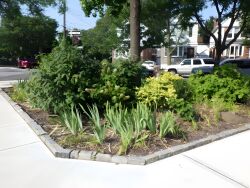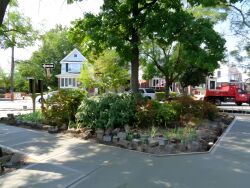Federalist Triangle
Federalist North Triangle
This triangle’s name was inspired by the adjacent Hamilton Place, named for the American Revolution era patriot Alexander Hamilton (1755-1804), and the Federalist movement of which he was a participant.
Born on the island of Nevis in the British West Indies, Hamilton moved to New York City in 1772 and attended King’s College (now Columbia University). With the outbreak of the Revolutionary War in 1776, Hamilton volunteered for service in a New York artillery company. A year later, General George Washington (1732-1799), made Hamilton his aide and secretary. In 1780, Hamilton cemented his rising position by marrying Elizabeth Schuyler (1757-1854), a member of one of New York’s most prominent families. Two years later, he was admitted to the New York State Bar, and was selected as a delegate to the Continental Congress.
In 1787, Hamilton attended the Constitutional Convention in Philadelphia. An ardent believer in Federalism, Hamilton argued vigorously for the Constitution’s ratification in a series of articles co-authored with James Madison (1751-1836) and John Jay (1745-1829), known today as After his tenure as President Washington’s first Secretary of the Treasury, Hamilton returned to New York and continued to argue Federalist views. In 1801, he helped to found the New York Evening Post, known today as the New York Post, as a platform for expressing his views. Hamilton soon, however, came into conflict with Aaron Burr (1756-1836), another New York lawyer and politician. After Hamilton supported Jefferson for the presidency over Burr in 1800, and then supposedly slandered Burr, Burr challenged Hamilton to duel. Although he had lost his eldest son Philip (1782-1801) in a duel in 1801, Hamilton nevertheless accepted the challenge. At Weehawken, New Jersey, on July 11, 1804, Burr fatally shot Hamilton. Dying a few days later, Hamilton was buried in Manhattan’s Trinity Church Cemetery.
Federalist politicians secured power in New York City largely through the imposition of property restrictions on voting. The Federalist Party controlled the City Common Council until 1804, when voting laws became more liberal. The party regained control in 1806 and 1809. Since they favored commercial and diplomatic concord with Britain, the Federalists gained popularity with Americans who opposed the War of 1812, retaining control until 1815. The party disintegrated nationwide during the early 1800s, and completely disappeared from the City by 1820.
Parks acquired this property in February 1927. The park originally held a concrete walk, shrubs, a central circle with a hedge and flagpole, and grass. The park contains several small trees and shrubs, as well as flowering bushes. There is now a brick walkway in the park as well. Federalist Triangle is now part of the Greenstreets program, a joint project of Parks and Transportation begun in 1986 and revived in 1994. Its goal is to convert paved street properties, such as triangles and malls, into green spaces.
Check out your park's Vital Signs
Clean & Safe
Green & Resilient
Empowered & Engaged Users
Share your feedback or learn more about how this park is part of a
Vital Park System




